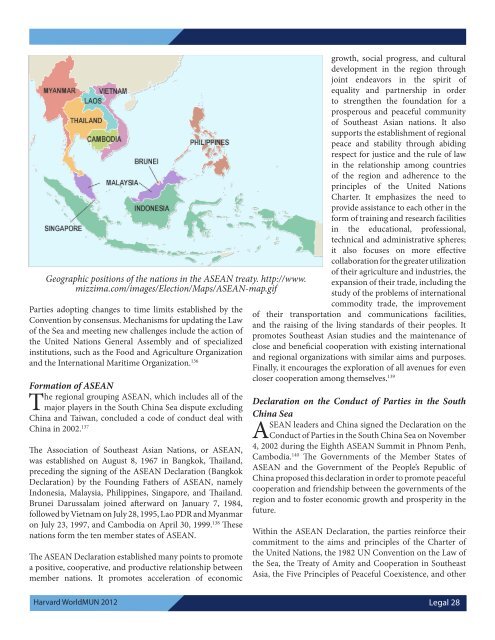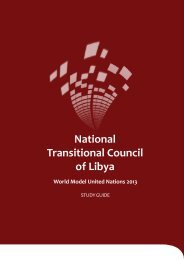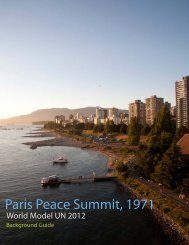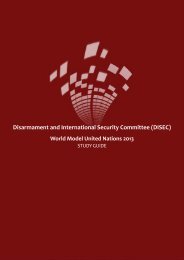Legal Committee - World Model United Nations
Legal Committee - World Model United Nations
Legal Committee - World Model United Nations
Create successful ePaper yourself
Turn your PDF publications into a flip-book with our unique Google optimized e-Paper software.
Geographic positions of the nations in the ASEAN treaty. http://www.<br />
mizzima.com/images/Election/Maps/ASEAN-map.gif<br />
Parties adopting changes to time limits established by the<br />
Convention by consensus. Mechanisms for updating the Law<br />
of the Sea and meeting new challenges include the action of<br />
the <strong>United</strong> <strong>Nations</strong> General Assembly and of specialized<br />
institutions, such as the Food and Agriculture Organization<br />
and the International Maritime Organization. 136<br />
Formation of ASEAN<br />
The regional grouping ASEAN, which includes all of the<br />
major players in the South China Sea dispute excluding<br />
China and Taiwan, concluded a code of conduct deal with<br />
China in 2002. 137<br />
The Association of Southeast Asian <strong>Nations</strong>, or ASEAN,<br />
was established on August 8, 1967 in Bangkok, Thailand,<br />
preceding the signing of the ASEAN Declaration (Bangkok<br />
Declaration) by the Founding Fathers of ASEAN, namely<br />
Indonesia, Malaysia, Philippines, Singapore, and Thailand.<br />
Brunei Darussalam joined afterward on January 7, 1984,<br />
followed by Vietnam on July 28, 1995, Lao PDR and Myanmar<br />
on July 23, 1997, and Cambodia on April 30, 1999. 138 These<br />
nations form the ten member states of ASEAN.<br />
The ASEAN Declaration established many points to promote<br />
a positive, cooperative, and productive relationship between<br />
member nations. It promotes acceleration of economic<br />
growth, social progress, and cultural<br />
development in the region through<br />
joint endeavors in the spirit of<br />
equality and partnership in order<br />
to strengthen the foundation for a<br />
prosperous and peaceful community<br />
of Southeast Asian nations. It also<br />
supports the establishment of regional<br />
peace and stability through abiding<br />
respect for justice and the rule of law<br />
in the relationship among countries<br />
of the region and adherence to the<br />
principles of the <strong>United</strong> <strong>Nations</strong><br />
Charter. It emphasizes the need to<br />
provide assistance to each other in the<br />
form of training and research facilities<br />
in the educational, professional,<br />
technical and administrative spheres;<br />
it also focuses on more effective<br />
collaboration for the greater utilization<br />
of their agriculture and industries, the<br />
expansion of their trade, including the<br />
study of the problems of international<br />
commodity trade, the improvement<br />
of their transportation and communications facilities,<br />
and the raising of the living standards of their peoples. It<br />
promotes Southeast Asian studies and the maintenance of<br />
close and beneficial cooperation with existing international<br />
and regional organizations with similar aims and purposes.<br />
Finally, it encourages the exploration of all avenues for even<br />
closer cooperation among themselves. 139<br />
Declaration on the Conduct of Parties in the South<br />
China Sea<br />
ASEAN leaders and China signed the Declaration on the<br />
Conduct of Parties in the South China Sea on November<br />
4, 2002 during the Eighth ASEAN Summit in Phnom Penh,<br />
Cambodia. 140 The Governments of the Member States of<br />
ASEAN and the Government of the People’s Republic of<br />
China proposed this declaration in order to promote peaceful<br />
cooperation and friendship between the governments of the<br />
region and to foster economic growth and prosperity in the<br />
future.<br />
Within the ASEAN Declaration, the parties reinforce their<br />
commitment to the aims and principles of the Charter of<br />
the <strong>United</strong> <strong>Nations</strong>, the 1982 UN Convention on the Law of<br />
the Sea, the Treaty of Amity and Cooperation in Southeast<br />
Asia, the Five Principles of Peaceful Coexistence, and other<br />
Harvard <strong>World</strong>MUN 2012 <strong>Legal</strong> 28

















